Airport Extreme (5th Gen) and Time Capsule (4th Gen) Review - Faster WiFi
by Brian Klug on August 5, 2011 10:22 PM EST- Posted in
- Mac
- Airport Extreme
- Time Capsule
- WiFi
WiFi Performance Testing—Methodology
To settle this, I decided on a testing methodology for comparing both generations of Airport Extreme, and the latest generation Time Capsule on two different platforms with 3x3:3 support, and a 2x2:2 design.
The first is a Lenovo X300 notebook. I acquired one of Intel’s latest and greatest WLAN cards, the Centrino Ultimate-N 6300, which is a dual-band 3x3:3 half height mini PCIe x1 card for notebooks.
It’s Intel’s highest end card, which I hastily inserted into the X300. Interestingly enough, I encountered an issue with installing just any WLAN card in the X300—it appears that Lenovo has some built in BIOS protection which prevents installation of “unauthorized” WiFi cards. Fortunately, the adjacent mini PCIe slot (ostensibly intended for cellular WAN) has no such protection. However, I then noticed another problem—the card wouldn’t turn on.
Some more searching revealed the solution—pin 20 (wireless disable) needs to be taped over to signal the card that the wireless disable switch (which doesn’t exist, since this is the WAN port) is in the on position. A quick surgical application of tape, and the card worked perfectly—take that, Lenovo security. As an aside, what a completely pointless and trivial barrier this is—the Mini PCIe standard (and moreover WiFi notebook cards themselves with U.FL connectors) are designed to be completely and absolutely interchangeable. The notion that this provides any added security (when the adjacent slot is completely unguarded) or—even more absurd, convenience—is nothing short of a surrealist notion.
My second testing platform was a 2010 MacBook Pro, which has a 2x2:2 solution provided by a BCM4322 based design. Finally, a 2011 MacBook Pro with a BCM4331 based 3x3:3 solution was my last test platform.
I tested in four locations in my home which has a loft-like two level layout and cinder block construction. My office is upstairs and in a corner, where the AP sits on a shelf about 5 feet in the air resting in its normal operating position (marked AP). Normally I mount the Airport Extreme on the wall in the vertical position using an Air Mount wall bracket, but for testing I relocated everything to a shelf for ease of changing between multiple devices and drives.
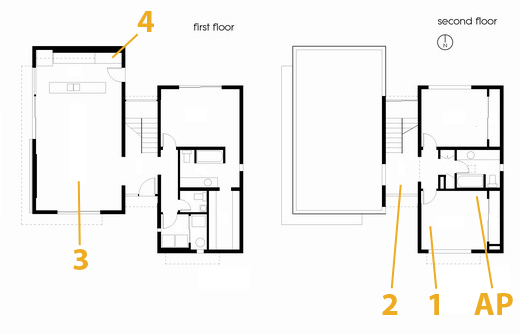
The first position (marked 1) is inside the office and on a relatively standard wooden desk. The next test location (marked 2) is in the stairway on a metal desk made out of a conductive material (likely aluminum). Downstairs are locations 3 and 4. Location 3 is on a wooden coffee table, to emulate just using the device while watching TV, and Location 4 is the most challenging position in the house in the corner of the kitchen.
The downstairs living room and kitchen area has proven to have challenging and undesirable RF propagation characteristics with the AP in my office, as the signal must propagate through two cinder block walls and change elevation. In addition, the entire staircase is one solid piece of steel, with the middle portion almost a quarter inch thick. If you draw a line from the AP to location 4 it’s pretty obvious that the testing location is directly in a shadow cast by the huge staircase.
In reality, testing is best performed in an anechoic chamber or some other completely controlled environment, but alas I lack any access to one and thus we’ll have to go with a real-world environment instead. I also did as much of my testing as possible after midnight to cut down on spurious interference from neighboring APs. Luckily I’m not in a dense urban environment and interference isn’t much of an issue.
For testing, I configured the APs to use channels 11 and 157 for 2.4 and 5GHz respectively, separate 2.4 and 5GHz AP names for manual selection, and 40 MHz channels on 5GHz. As a reminder, Apple still doesn’t allow for the use of 40 MHz channels on 2.4GHz in order to not use so much spectrum that it degrades Bluetooth HID performance.
For testing network throughput, I settled on two different things. First is Apple File Protocol (AFP) which is easy enough to test by creating an AFP share on one computer and then transacting huge files and averaging network bandwidth. Because I lack additional Macs, I turned to a positively ancient 2GHz iMac G5 with 2GB of RAM running 10.5.8 that I fixed a while ago. Rest assured, the iMac G5 does have a 1 GigE port with jumbo frame support, and ample power to serve this purpose. Instead of installing an SSD to guarantee that the sluggish HDD wasn’t throttling AFP performance, I created a 1GB RAMdisk and shared it on the network. The RAMdisk can do around 300MB/s sustained reads and writes locally and almost 800 Mbps over ethernet, so we’re not artificially bottlenecked. For a test file, I used a 500MB zip of AVCHD video and some random huge PDFs.
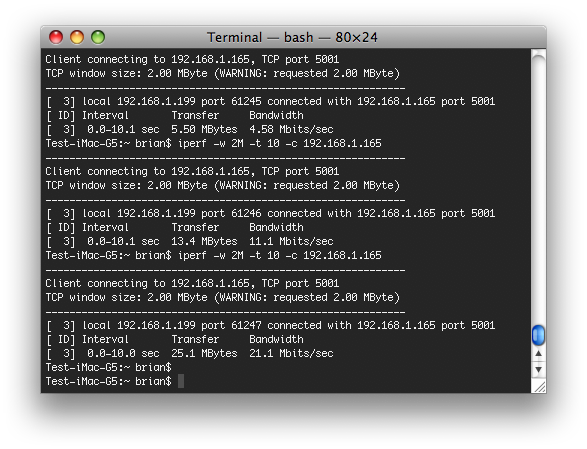
The second test I settled on is the cross-platform, open source iperf which is a network tool for measuring TCP network throughput among a bunch of other things. I compiled iperf 2.0.5 from source on all three Macs (yes, even a PPC binary for the 10.5.8 iMac G5), and used a version in conjunction with Cygwin on the Windows based notebook. After some tuning in my office I settled on a 2MB TCP window for maximizing throughput.
When I set up this testing, I was interested in really three things. First, the Modulation Coding Scheme (MCS) being used at each location, which tells you the data rate of the wireless link and how many streams are in use. Second, the received power level to see if I could measure a difference thanks to the increased power in the newer generation routers. Finally, actual network throughput both up and down on the wireless link.
On the Macs, it’s easy enough to get both MCS and RSSI. You can either run:
/System/Library/PrivateFrameworks/Apple80211.framework/Versions/Current/Resources/airport -I
and look at the output, or option-click on the WiFi symbol.
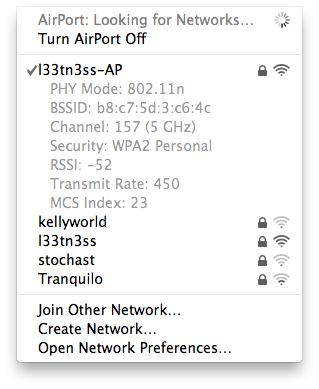
On Windows, getting this information is a bit more challenging as you have to rely on the WLAN card maker supplying a utility that shows any good details. Intel doesn’t directly show RSSI unless you enable logging in the advanced statistics utility and cross-correlate with samples recorded every second or so, and this proved far too time consuming. For MCS, you have to abstract backwards from the rate shown in the wireless network connection status using a table.


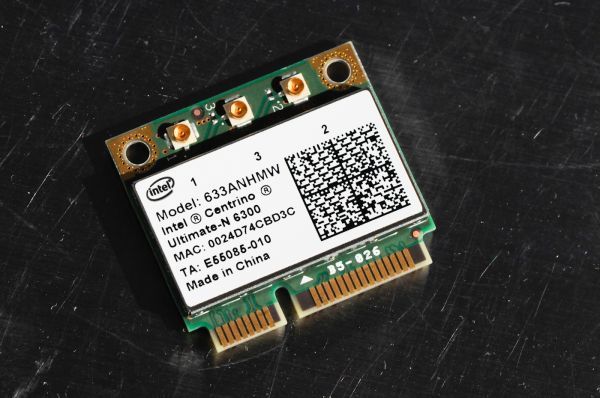
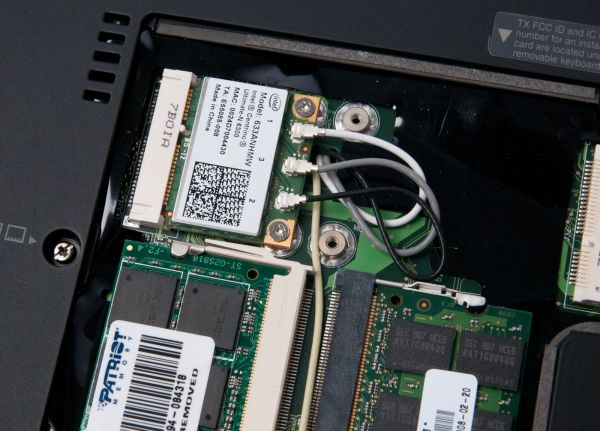
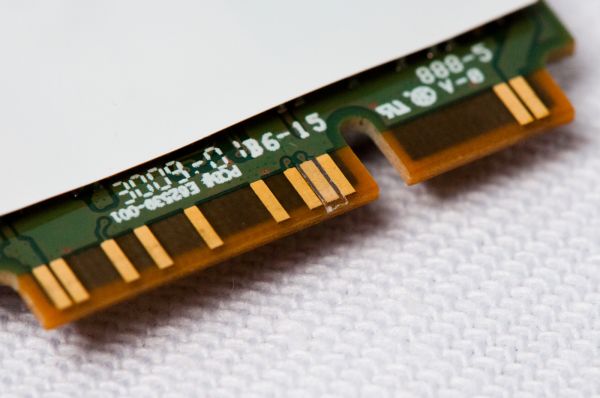








90 Comments
View All Comments
jackwong - Sunday, August 14, 2011 - link
It is more about the data on the TC, and it runs EXTREMELY hot during Summer...This is my setup, Airport Extreme base station, Synology 1 bay with 2TB, and a Sesgate goflex 2.5" 1.5TB to backup the Synology. These cost me ~$550 but if the nas has problem, I can still have all the data on the 1.5TB Seagate.
name99 - Saturday, August 6, 2011 - link
Then don't buy one.Connect a USB drive to your Airport base station.
Or use network time machine to back up to whatever home server/HTPC mac you have sitting around. That's what I do.
I honestly do not understand why people feel compelled to tell the world: "this product is a bad match for me and my needs and therefore no-one should ever use it".
Do you apply the same logic to, I don't know, Intel chips? Damn those Xeon's are expensive --- and they even run at slower rates than my i5. Anyone who buys one is obviously an idiot.
HilbertSpace - Saturday, August 6, 2011 - link
Did you try putting the mini Broadcom PCIe into the Gen 4 Airport Extreme and seeing if you can do an upgrade that way?Brian Klug - Saturday, August 6, 2011 - link
I considered it for a long time, but decided that I wasn't sure it was worth spending too much time on (particularly because I have no idea where you could buy just the card) and because there's ostensibly some firmware flash that must go along with the Gen 5. I'm not sure whether there's a way to force a firmware update with the Gen 5 firmware on a Gen 4.-Brian
Signalius - Monday, October 29, 2018 - link
Now that it’s 2018 and these units can be found at thrift stores for $10, is there any sense in attempting to improve an A1301 (3rd gen) Extreme with the wifi card from a dead A1408 unit?hechacker1 - Saturday, August 6, 2011 - link
The only missing feature IMHO is some type of QoS management and uPNP.I have a 4th Gen Airport Extreme, and as you say it's a stable router that just seems compatible with everything (everything connects reliably).
I'd love to upgrade to the 5th Gen for the extra power (that's surprising Apple cranks it up that high), but when it comes to using p2p and gaming at the same time, the lack of QoS prioritization kills it.
Then it doesn't have uPnP, which more broadly supported than NAT-PMP. The Airport also has a nasty bug of forgetting your port forwardings and MAC address bindings, as soon as the network card sleeps for too long (a few hours).
So it's back to a router that supports more open features and can also have its radios power cranked up to match the Airport. There's a few good dual band routers out there are are pretty much all open source (even the wireless chip!).
Zok - Saturday, August 6, 2011 - link
Like what? I bought a Netgear WNDR3700 quite some time ago because it was one of the highest performing dual band / dual radio devices at the time (supposedly the SoC was faster than it's competitors).That said, it's been an absolute nightmare to get DD-WRT on it and stable (radio performance and range gets trashed) and the factory GUI is severely lacking (doesn't allow for PAT, for example). Have any suggestions on something DD-WRT compatible, but can also drive dual radios for both bands (2x2 or 3x3, 40 MHz on both, preferable)?
hechacker1 - Saturday, August 6, 2011 - link
I'm using OpenWRT on the 3700v2. Check out the OpenWRT forums for community builds that let you set the radios to their max power output (24dBm on 5GHz 40MHz, 27dBm on 2.4GHz 40MHz). It reaches the hardware limit.Surprisingly, the new Airport Extreme has slightly more power output at 5GHz than the 3700v2.
OpenWRT has been stable on this router for me. It's a great alternative to the Airport if you want LOTS of power output and open source software with tons of features.
The biggest con with OpenWRT is that its interface sucks; but whatever, you only have to set it up once.
name99 - Saturday, August 6, 2011 - link
uPNP I couldn't give a damn about, and neither can Apple.They have their solution for devices transparently connecting to each other, in the form of Bonjour, and that's not going to change. Like NAT-PMP it's an IETF standard and, for all the complaints otherwise, Apple is actually a pretty standards compliant company.
The two obvious (IMHO) missing features (which could both be added with software, at least to some extent) are QoS and transparent caching (most easily by running squid on the device and having it store the cache on any attached storage --- stick in an 8GB USB flash drive if you have nothing better). I continue to think that the rumors regarding base stations being part of iCloud will likely prove true in the long run --- it's to Apple's obvious advantage to be able to offload as much work to base stations as possible via transparent caching.
I also have no idea what the complaint about "forgetting your port forwardings" refers to. I used a 3rd gen extreme for years, and switch to a 4th gen about six months ago, and I have NEVER had my port forwardings forgotten or borked in any way.
Personally if someone is going to complain, the real item to complain about is the USB performance which was so crappy it was unbelievable in the 3rd gen, and appears unimproved even today. Come on, Apple --- even if the Marvell chip is garbage, spend the extra buck and buy a decent 3rd party USB controller. I think the best we can hope for is that the 6th gen device uses an upgraded Marvell chip with a USB3 controller that is lousy by the standards of USB3, but gives at least say 60MB/s.
edporras - Tuesday, August 9, 2011 - link
QoS would definitely be handy but not having the ability to forward port 53 just killed me. I really wish there was a way to disable the ABS' DNS server. Or if anyone has figured it out, please share.